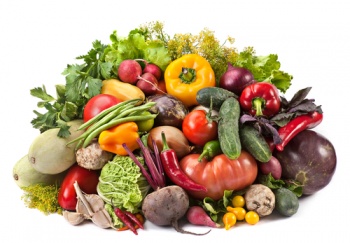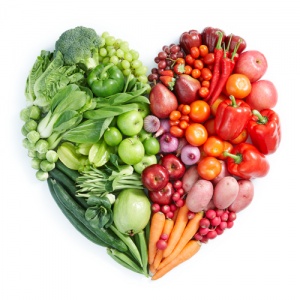Vegetables
| See Also | Clinical Nutrition |
|---|
A vegetable is the fresh, edible portion of a herbaceous plant which can include the roots, stems, leaves, flowers, or fruit.[1]
Contents
Classification
Vegetables are classified according to the part of the plant that is eaten. Some vegetables may fall into more than one category as more than one part of the same plant is eaten. [1], [2]
- Bulb vegetables: Bulbs are usually grown just below the surface of the ground and produce a fleshy, leafy shoot above ground and usually consist of layers or clustered segments.
- Examples: Garlic, leek, onion, scallion, shallot etc.
- Flower vegetables: Flower vegetables so named because they are the buds of flowers.
- Examples: Artichoke, broccoli, broccoli rabe, cauliflower
- Fruit vegetables: Vegetable fruits are fleshy and contain seeds and vary widely in their appearance, structure, and composition.
- Examples: Avocado, bell pepper, chayote, cucumber, eggplant, okra, olive, squash, tomato
- Leaf vegetables: Leaf vegetables are valued because of their mineral and salts content. They are juicy in nature and are often called succulent vegetables.
- Examples: Cabbage, chicory, cress, dandelion, lettuce, nettle, radicchio, sorrel, spinach
- Root vegetables: Are a long or round-shaped taproot.
- Examples: Beets, burdock, carrot, celeriac, malanga, parsnip, radish, rutabaga, turnip
- Stem vegetables: Stem vegetables indicate it’s the stem or stalk of the vegetable that is eaten. Often both the bulb and the stems of these plants are also consumed.
- Examples: Asparagus, bamboo shoot, cardoon, celery, chard, fennel, fiddlehead, kohlrabi, etc.
- Tuber vegetables: Tubers are vegetables which grow underground on the root of a plant.
- Examples: Beets, cassava, Chinese artichoke, Jerusalem artichoke, jícama, potato, sweet potato, taro, yam
There are two additional groups of vegetables that are not classified based on the part of plant from which they are derived: Sea Vegetable and Fungi
- Sea Vegetables: Are those vegetables that grow in the sea.
- Examples: Aornori, dulse, kombu, nori, sea lettuce, wakame
- Fungi: Funghi is a term given to a wide variety of mushrooms.
- Examples: Cantharell, honey, morel, oyster, shiitake, straw, truffle
Nutritional Value
Each vegetable varies to some degree with respect to its composition.[1], [3]
- As a category of food, vegetables are generally comprised of simple or complex carbohydrates, water, and very little protein.
- Vegetables contain no cholesterol, have little or no fat, and provide valuable vitamins such as vitamin A, K, and B6, dietary minerals and fiber. As such vegetables are considered to be quite nutrient dense relative to the number of calories they contain.
- Vegetables also contain non-nutrients such as polyphenols and phytochemicals which can have antioxidant, antibacterial, antifungal, antiviral and anticarcinogenic effects on the body.
Following is a general rule of thumb regarding the nutrition offered by vegetables: [3]
- Dark green leafy vegetables usually offer the richest source of nutrients.
- Light green vegetables provide a number of vitamins, minerals and a substantial amount cellulose (a carbohydrate) which has a bulking effect in the diet.
- Yellow and dark green vegetables are wonderful sources of vitamin A and beta-carotene.
- Vegetable leaves are rich in calcium, iron, magnesium, vitamin C, and many of the B vitamins.
- Cruciferous vegetables (e.g. broccoli) are rich in phytochemicals.
Health Benefits
Following is a list of commonly consumed vegetables and their health benefits:[4], [5], [1]
- Asparagus: is a great source of the antioxidant glutathione which is known to reduce the risk of cancer.
- Avocados: are a vasodilator which benefits circulation, lowers cholesterol, and are one of the richest sources of glutathione. Its main fat, monounsaturated oleic acid, acts as an antioxidant to block LDL cholesterol.
- Beets: are rich in iron and other minerals. Their greens are helpful in cases of anemia, tuberculosis, poor appetite, gout, and acne and are known to be hepatoprotective. Beets are one of the best foods to help relieve constipation.
- Bell Peppers: are rich in the antioxidant vitamin C and have been shown to be effective in the aid of asthma, bronchitis, respiratory infections, cataracts, macular degeneration, angina, atherosclerosis and cancer.
- Broccoli: has a number of powerful actions:
- It is abundant in antioxidants, including quercetin, glutathione, beta carotene, indoles, vitamin C, lutein, glucarate, and sulforaphane, and is a great source of chromium which helps regulate insulin and blood sugar.
- It is extremely high in cancer fighting activity, particularly against lung and colon, and like other cruciferous vegetables, it speeds up removal of estrogen from the body, helping lower the risk of breast cancer.
- Broccoli is also rich in cholesterol-reducing fiber and has antiviral, anti-ulcer activity.
- Broccoli is most protective when eaten raw or lightly cooked as some of these agents are destroyed with heat.
- Brussels Sprouts: are also a member of the cruciferous family and therefore possesses some of the same actions as broccoli and cabbage. Most importantly, they have been shown to be high in antioxidants and indole which fight cancer and are estrogenic in nature.
- Cabbage (including bok choy): has long been revered as having powerful anticancer properties.
- It contains numerous antioxidant compounds, speeds up estrogen metabolism, and is thought to help block breast cancer and suppress growth of polyps, a prelude to colon cancer.
- Eating cabbage more than once a week has shown to reduce men's colon cancer odds up to 66%, and as little as two daily tbsp. of cooked cabbage has been shown to protect against stomach cancer.
- Cabbage has antibacterial and antiviral properties, and its juice can help heal ulcers.
- Some people may experience flatulence or migraines when consuming cabbage in the form of sauerkraut.
- Raw cabbage, (e.g. cole slaw) appears to have stronger overall health value.
- Carrots: are a super source of beta carotene, a powerful anticancer, artery-protecting, immune-boosting, and infection-fighting antioxidant with widely protective properties.
- The beta carotene contained in one carrot that's consumed each day has been shown to cut lung cancer risk in half, even among formerly heavy smokers.
- High doses of beta carotene, as found in carrots, also substantially reduce the odds of degenerative eye diseases such as cataracts and macular degeneration as well as chest pain (angina).
- The high soluble fiber in carrots depresses blood cholesterol and promote regularity.
- Cooking does not destroy beta carotene and can make it easier for the body to absorb this carotenoid.
- Celery: is a traditional remedy for high blood pressure as it has been shown that consuming two to four stalks a day can be helpful with hypertension.
- Celery contains eight different families of anticancer compounds, such as phthalides and polyacetylenes, that detoxify pollutants and carcinogens, especially cigarette smoke.
- Celery also has a mild diuretic effect.
- Eating celery before or after vigorous exercise can induce mild to serious allergic reactions in some people.
- Eggplant. the glycoalkaloids in eggplant can be made into a topical cream medication and have been used to treat skin cancers such as basal cell carcinoma.
- Eggplant has antibacterial and diuretic properties and eating this vegetable may help to lower blood cholesterol and counteract some detrimental effects of fatty foods in the vasculature.
- Kale: is a member of the cruciferous family and is a rich source of cancer fighting antioxidants.
- Kale has more beta carotene than spinach and twice as much lutein as any other vegetable.
- Mushrooms (Maitake & Shiitake): research studies have shown mushrooms, such as maitake and shiitake help prevent and/or treat: cancer, viral diseases such as influenza and polio, sticky platelets, hypercholesterolemia and hypertension.
- Lentinan, a compound in shiitake mushrooms is a broad-spectrum antiviral agent that potentiates immune functioning.
- Shiitake mushrooms have been shown to decrease both fat and cholesterol in the blood and help discharge the excess residues of accumulated animal proteins.
- When eaten daily, maitake or shiitake, fresh (three ounces) or dried (one-third ounce), can cut cholesterol by 7% and 12% respectively.
- Onion (including chives, shallots, scallions, leeks): these plants contain a high amount of sulfur, which has a warming element that purifies the body and helps to remove any parasites or heavy metals.
- The onion is the richest dietary source of quercetin, a potent antioxidant (in shallots, yellow and red onions only).
- It has powerful antiviral, anti-inflammatory and anticancer properties and has been specifically linked to inhibiting stomach cancer in humans.
- Members of the onion family are also helpful in thinning the blood, lowering LDL cholesterol, raising HDL cholesterol (preferred dose: half a raw onion a day) and warding off blood clots.
- The pungent quality of onions make them especially effective in treating lung conditions such as asthma and chronic bronchitis.
- Onions have been known to aggravate heartburn in some people and may promote gas.
- Potato (white): Potatoes are considered to be one of the most nourishing foods if eaten with the skin intact, and have a variety of health benefits including:
- Fresh potato juice is considered to have antibiotic properties and can be applied externally to heal burns. It can also be drunk to treat stomach and duodenal ulcers and to help lower blood cholesterol.
- Potatoes are also known for their anti-inflammatory effects and contain anticancer protease inhibitors.
- Pumpkin: Pumpkins are extremely high in the antioxidant beta carotene and other carotenoids, and has been reputed to be helpful in treating numerous health problems, including heart attacks, cancer and cataracts.
- Seaweed, Dulse, Kelp: Seaweed offers a wealth of essential minerals including selenium - all of which are necessary to build immunity.
- Seaweed is a rich source of iodine which is used by enzymes in the body to combat against yeasts as in candida overgrowth.
- Tomato: although the tomato is an acidic fruit, once it has been digested, tomatoes actually alkalinize the blood and are therefore helpful in the treatment of gout, rheumatism. They have also been linked to lower rates of pancreatic and cervical cancers.
- Tomatoes are high in the essential amino acid lycopene.
- They are also known to promote digestion and often used in cases of indigestion, food retention, constipation and diminished appetite.
Specific Consideration
- Many vegetables (bell peppers, celery, spinach, lettuce, potatoes) are sprayed with pesticides and chemical fertilizers, which increase the toxic burden on the body when consumed. Consequently organic fruit is a safer option. [5], [6]
- Fresh, raw vegetables generally contain the most vitamins and minerals. Vegetables should be cooked as briefly as possible as they lose some of their nutrients during this process.
- Vegetables skins contain many of the vitamins and minerals and should be left on or pared as thinly as possible.
- Quick-freezing vegetables results in little to no nutrient loss.
- Commercially canned vegetables are often over-cooked which depletes the vegetables of their enzymes and nutrient value.
- Baked vegetables will have a higher concentration of nutrients than those that are boiled.
- It is important to wash vegetables thoroughly to remove any dirt or chemical sprays.
- It is best to cut vegetables into similar-sized pieces so that they cook evenly.
Recommended Intake
The recommended intake varies based on age and health status. To determine what your specific requirements are talk to your naturopathic doctor or other trained medical professional.
References
- ↑ 1.0 1.1 1.2 1.3 Margen S (1992) The Wellness Encyclopedia of Food and Nutrition Random House
- ↑ Spices and Medicinal Herbs http://www.spicesmedicinalherbs.com/classification-of-vegetables.html Retrieved 13 March 2012
- ↑ 3.0 3.1 Kirschmann and Kirschmann G (1996) Nutrition Almanac Fourth Edition McGraw-Hill
- ↑ Pitchford
- ↑ 5.0 5.1 Kirschmann and Kirschmann G (1996) Nutrition Almanac Fourth Edition McGraw-Hill.
- ↑ Organic: The Dirty Dozen http://www.organic.org/articles/showarticle/article-214 Retrieved 13 March 2012.

